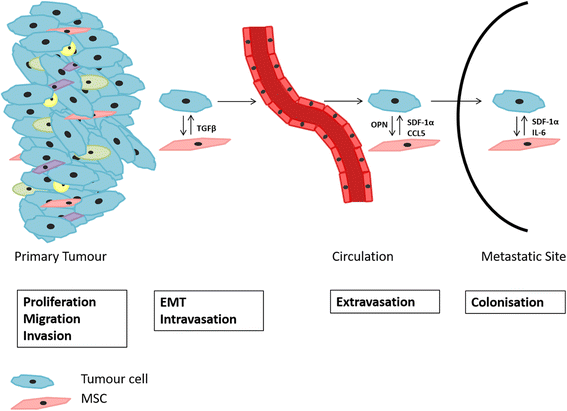Mesenchymal stem cells: key players in cancer progression
- PMID: 28148268
- PMCID: PMC5286812
- DOI: 10.1186/s12943-017-0597-8
Mesenchymal stem cells: key players in cancer progression
Abstract
Tumour progression is dependent on the interaction between tumour cells and cells of the surrounding microenvironment. The tumour is a dynamic milieu consisting of various cell types such as endothelial cells, fibroblasts, cells of the immune system and mesenchymal stem cells (MSCs). MSCs are multipotent stromal cells that are known to reside in various areas such as the bone marrow, fat and dental pulp. MSCs have been found to migrate towards inflammatory sites and studies have shown that they also migrate towards and incorporate into the tumour. The key question is how they interact there. MSCs may interact with tumour cells through paracrine signalling. On the other hand, MSCs have the capacity to differentiate to various cell types such as osteocytes, chondrocytes and adipocytes and it is possible that MSCs differentiate at the site of the tumour. More recently it has been shown that cross-talk between tumour cells and MSCs has been shown to increase metastatic potential and promote epithelial-to-mesenchymal transition. This review will focus on the role of MSCs in tumour development at various stages of progression from growth of the primary tumour to the establishment of distant metastasis.
Keywords: Cancer progression; Mesenchymal stem cells; Tumour metastasis; Tumour microenvironment; Tumour stroma.
Figures

References
-
- Young MR, Wright MA. Myelopoiesis-associated immune suppressor cells in mice bearing metastatic Lewis lung carcinoma tumors: gamma interferon plus tumor necrosis factor alpha synergistically reduces immune suppressor and tumor growth-promoting activities of bone marrow cells and diminishes tumor recurrence and metastasis. Cancer Res. 1992;52(22):6335–40. - PubMed
Publication types
MeSH terms
LinkOut - more resources
Full Text Sources
Other Literature Sources

